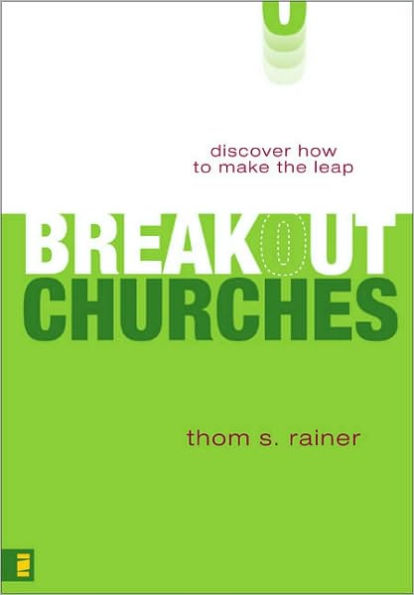Read an Excerpt
It is a sin to be good if God has called us to be great.
Christians refer to Matthew 28:18-20 as the Great
Commission, not the Good Commission. Jesus himself said that the words we read
in Matthew 22:37 and 39 are the Great Commandments, not the Good Commandments.
And the apostle Paul did not call love something that is good; instead, he said "the greatest of these
is love" (1 Cor. 13:13, emphasis added).
The power of seeking to be great rather than good became clear when I read
Jim Collins's book Good to Great: Why Some Companies Make the Leap . . . and
Others Don't, in which he began with the opening line:"Good is the enemy of
great."With the encouragement of my publisher I elected to write a book on
churches, modeled on the Good to Great framework.
This book was inspired by Good to Great, and we borrowed the research
process, the structure and outline of the book, and the architecture of its
ideas as the blueprint for this work.
THE DIFFICULTIES IN FINDING GREAT CHURCHES
Think of some criteria to measure great churches. Attendance increases?
Number of conversions? Impact on culture? Transformed lives? If you have settled
on one or more criteria, name fifty churches that would meet them.
Can you
name forty churches? Thirty?
Let's make the search more difficult. Think of churches
that meet your "great" criteria after being a so-so church for many years. In
other words, discover some churches that have made the leap to greatness. Let's make the
test even more problematic.Name all the churches that have made the transition
without changing the senior pastor or senior minister.
In other words, the church broke out under the same
leadership. If you are having trouble naming several such churches, you have a
taste of the difficulties the research team encountered in this project.We
believe, quite
simply, that there are very few breakout churches in America.
In fact, although we have data on thousands of churches, we found only
thirteen churches that survived the rigorous screening. But the lessons we
learned from these churches are priceless.
Figure 1A offers a quick snapshot of the incredible
leaps taken by breakout churches. Following the research methodology used by Jim
Collins in Good to Great, we compared the thirteen churches we found with a
carefully selected control group of churches that failed to make the leap. The factors
distinguishing one group from the other fascinated our team.
As just one point of comparison, the chart looks at
worship attendance of the two groups of churches. The breakout churches had a
clearly identified point at which they began to experience significant growth.
Drawing upon the Good to Great terminology of "transition point," we called this juncture the
"breakout point."We then took the five years preceding and the five years
following the breakout point and compared the same years with the direct
comparison churches.
For the five years prior to breakout, all of the
churches were struggling to stay even in worship attendance. Then the difference
between the two groups is dramatic. The average worship attendance of the
comparison churches declined
for the next five years, while in the breakout churches it increased 71
percent.
BREAKOUT CHURCHES
How did churches with very unremarkable pasts become great churches? What
took place in these fellowships that made them so extraordinary?
How did these churches make the leap when more than 90 percent of American
churches did not come close to doing so?
Can a good but plodding church become a great church? We believe the answer
is an unequivocal yes.We hope the stories you are about to read will inspire you
to move your church to greatness. Before we get too caught
up in the details,
let's hear from one church that made the transition-but not without a great
sacrifice at great cost.
THE TEMPLE CHURCH FACES THE COST OF MAKING THE LEAP
The Temple Church opened its doors for its first worship service at the
American Baptist Theological Seminary in Nashville, Tennessee, in 1977. The
congregation subsequently met in two other borrowed facilities
before
constructing its own buildings in 1980. The founding pastor was
Bishop
Michael Lee Graves.
By most standards, The Temple Church was successful from its inception.
Growth was steady, if not spectacular, in the early years.A Christian
private
school began. An adjunctive ministry, Samaritan's Ministries, reached out to the
inner city of North Nashville by providing nutritional
Figure 1A. Attendance of Breakout Churches and Comparison Churches
WHY GOOD IS NOT ENOUGH: THE CHRYSALIS FACTOR
support for the hungry, medical assistance, spiritual and psychological
counseling, and educational and vocational training. One leader in the community
credited The Temple Church with playing a major role in reducing
drug and
gang violence in the area.
The list of Temple's ministries exceeded fifty and was growing. The church
was one of the most respected African-American churches in the early 1980s. A
multimillion-dollar facility was complete. The members
began to see their
identity with the church as a banner of prestige. The Temple Church, by most
standards, was making a difference. Then the
crash came.
As researcher George P. Lee discovered, not many people recognized that a
crash had taken place.True, worship attendance declined from 1,000
in 1984 to
880 in 1985. But Bishop Graves, the only person to sense trouble, felt the
decline in attendance was only symptomatic of greater problems.
"There was a
sense of apathy growing among the members," Graves reflected. More important, he
sensed that God's vision for The Temple
Church was for it to be a multiracial, multiethnic church for people of all
socioeconomic classes. Yet by 1985 the church was the home largely of middle-
and upper-middle-class African Americans.
"The vision of The Temple Church was a vis



